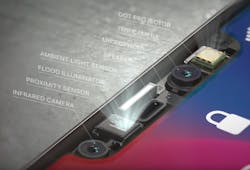Armed with three photos from Facebook, a company was able to 3D print a mask that could fool face-recognition software. The mask was in three dimensions, and included colors of the skin tone and eyes. While it also cost almost $340, it showed that it is possible to hack this type of software. ThatsMyFace in Oregon will send you a 3D-printed replica of your face from only two pictures that has also tricked some security systems.
Matt Lewis, research director of NCC Group, a cybersecurity company in London, says, “Businesses aren’t deliberately making masks to spoof biometrics, but the fact that the masks can trick commonly used systems shows the challenge security companies face.”
But, meanwhile, companies push for features that allow you to pay with facial recognition, and the new iPhone uses your face to unlock.
At left is a 3D-printed mask that was able to be used to try and fool facial-recognition software. However, Apple’s new iPhone X sounds like it can stay a step ahead of masked hackers.
Should we be concerned? Apparently not. Security software is much more sophisticated today. Something as simple as asking a person to blink makes it exponentially harder for a person to hack this technology. Add to this thermal scans and infrared capabilities, and Apple thinks this is better than a fingerprint.
A recent article in Macworld noted, “Instead of one or more fingerprints, as with Touch ID, Face ID relies on the unique characteristics of your face. Apple is betting that its technology can meet five separate hurdles:
- Initially scan your face accurately enough to recognize it later.
- Compare a new scan with the stored one with enough flexibility to recognize you nearly all the time.
- Scan your face in a wide variety of lighting conditions.
- Update your facial details as you age, change hairstyles, grow a mustache, change your eyebrows, get plastic surgery, and so forth to still recognize you.
- Not allow a similar-looking person, a photograph, a mask, or other techniques to unlock your phone.
“Apple uses a combination of infrared emitter and sensor (which it calls TrueDepth) to paint 30,000 points of infrared light on and around your face. The reflection is measured, which allows it to calculate depth and angle from the camera for each dot. That lets it both create a kind of 3D fingerprint of your face that can used to compare against later…”
Multiple technologies are used for Apple’s face recognition to work. For example, the illuminator is to sense the reflection of the face and better aids Truedepth’s infrared.
So unless you have an identical twin or clone using face recognition with infrared technology, you stand a one in a million chance of being hacked, Macworld wrote.
As technology advances, staying one step ahead of hackers may be difficult but necessary, and teaming multiple technologies together will provide more security as people demand easier but safe access to anything from their bank information to their vacation photos. If users still aren’t ready to adopt this technology, they can always disable it.


